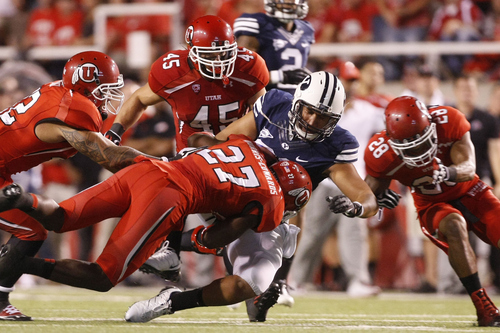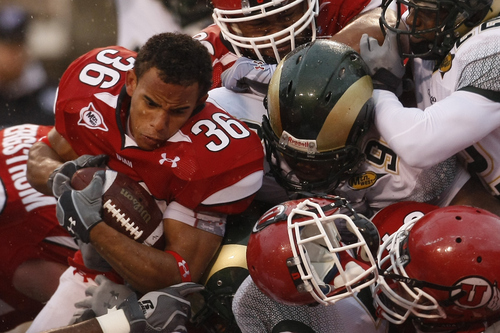This is an archived article that was published on sltrib.com in 2013, and information in the article may be outdated. It is provided only for personal research purposes and may not be reprinted.
College coaches everywhere will be holding their breath when helmets hit helmets this football season.
The threat of injury is the ultimate fear for any coach. But since NCAA officials have pledged to call targeting penalties more aggressively this fall, the threat of ejection could be much more frequent.
Coaches across the country are torn as to whether the NCAA's changes will help clean up the game or simply put more players on the sidelines.
"It's good that there's rules against targeting, but my disappointment is targeting is going to be called much more often," San Diego State coach Rocky Long said at Mountain West media days. "I'm guessing after close review, give it a few days and we'll see that there were some missed calls. There's a good chance you're going to miss some of your best players."
The rules on targeting — a penalty that generally protects players from hits to the head, spearing and hits when they're defenseless — have not changed. What has changed is that referees everywhere have been directed to look harder for targeting and eject the players who do it, said Walt Anderson, the Big 12's coordinator of officials.
Anderson said in a media seminar that the goal was to clamp down on what he termed "avoidable hits." Officials will punish harshly high and intentionally vicious hits, but Anderson acknowledged even unintended head-to-head contact could get whistled.
That narrow line is where many coaches start getting anxious.
As various conferences hosted media days in the past weeks, there was clear apprehension from the nation's top football programs. SEC coaches were stunned after hearing ACC official Doug Rhoads' comment that he would have ejected Jadeveon Clowney for his famed helmet-ejecting tackle in the Outback Bowl last year.
Coaches take the issue seriously when the word ejection is bandied about. With the season a month away, several said it's become a much-discussed issue in their locker rooms.
"When you talk about disqualifying a kid or ejecting him from a game, I think of that as something that he had total control over, or he did something really stupid," New Mexico coach Bob Davie said. "With targeting, that angle changes in a split-second. If I've already had my aiming point at where I'm going to tackle and that ballcarrier drops at the last second and we go helmet-to-helmet, now you're ejecting a kid from a game."
Officials will look for players leaping off the ground for tackles, thrusting toward the head, striking around the head or leading with the crown of their helmets. Anyone flagged for targeting gets a penalty and sits out the rest of the game. If a player is called for targeting in the second half, he misses the first half of the next game.
Coaches watched clips of potential flagged hits from previous seasons, and several walked away shaking their heads.
"Some of the clips they were showing us, we were like, 'Really? That's going to get a guy out of a game?' I'm very concerned," Boise State coach Chris Petersen said.
Coaches are briefing players on what kinds of hits might be penalized, scrutinizing not only where their players are hitting, but how. Petersen had a rugby coach talk to his team about how wrapping up more thoroughly could help players avoid high hits while still bringing opponents to the turf.
"I think wrapping up makes a big difference," he said. "That's what you see in rugby — they wrap up everything, and obviously they don't get their head involved."
Other coaches agree that while the targeting enforcement initially will leave fans kicking and screaming, the long-term changes will help the game overall. Colorado State coach Jim McElwain said he was more worried about his players than the officials, and he would use penalties as "teachable moments" to correct his players' techniques.
"I think it's something we needed to have happen, and now we need to adapt to it," he said. "There is some incidental contact, but it's really going to the intent. The guys who are trying to use their head as a battering ram — there are ways to avoid that."
Utah State coach Matt Wells said he'd take a wait-and-see approach to judging whether the rule will be effective.
"The thing that will be interesting to see play out is the angles the referees have and the challenge of calling it and understanding the intent of the defender," he said. "I think it's fairly obvious, but it's going to be a challenge because of the penalty."
kgoon@sltrib.comTwitter: @kylegoon Elements of targeting
Walt Anderson, the Big 12's coordinator of officials, presented key issues referees will look for on potential targeting calls. On any given hit, the risk of getting flagged will go up with:
Launching • Leaving one's feet to make a tackle. Defenders who launch themselves into the air make it impossible to change their body position before contact, which is a potential sign of recklessness.
Thrusting upward • Forcing your arms, shoulders or head up into another player's head or neck during a tackle. This is one of the more subtle and possibly controversial elements of targeting.
Striking about the head • Using any part of your body to hit other players in the head directly. Usually fairly obvious, and covers clothesline-style hits.
Leading with the crown • Putting your head down to spear someone with the crown of your helmet. Considered reckless and possibly dangerous to the tackler, this will be enforced no matter where the defender strikes.









